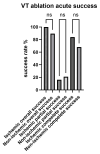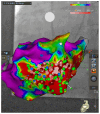Real World Data from Catheter Ablation of Ventricular Tachycardias and Premature Ventricular Complexes in a Tertiary Care Center
- PMID: 38673583
- PMCID: PMC11051534
- DOI: 10.3390/jcm13082310
Real World Data from Catheter Ablation of Ventricular Tachycardias and Premature Ventricular Complexes in a Tertiary Care Center
Abstract
Background: Catheter ablation in patients with ventricular arrhythmias (VA), such as ventricular tachycardias (VT) or frequent premature ventricular complexes (PVC), is increasingly considered an effective and safe therapy when performed in experienced centers. This study sought to determine acute success rates and complication rates of ablation procedures for patients with VA in a Swiss tertiary care center. Methods: All patients who underwent ablation therapy for VT and PVC at the University Heart Center in Zurich, Switzerland, between March 2012 and April 2017 were included in this analysis. Results: A total of 120 patients underwent catheter ablation for VT and PVC (69 and 51, respectively). Seventy percent of patients were male, and the mean age was 55.3 years. The most common indication for ablation was high PVC burden (47.5%), followed by paroxysmal VT (38.3%), ICD shocks (23.3%), incessant VT (12.5%), electrical storm (7.5%), and syncope (3.3%). Acute success rates for VT and PVC ablations were 94.2% and 92.2%, respectively. Rates for complications (including major and minor) for VT and PVC were 10.1% and 7.8%, respectively. Complications occurred only in patients with structural heart disease; no complications were noted in structurally normal hearts. Conclusions: Our results suggest that catheter ablation for VT and PVC has high acute success rates with a reasonable risk for complications in the setting of tertiary care centers, comparable to those reported in other studies.
Keywords: acute success; catheter ablation; clinical outcome; premature ventricular complex; ventricular tachycardia.
Conflict of interest statement
A.M.S. has received educational grants through his institution from Abbott, Bayer Healthcare, Biosense Webster, Biotronik, Boston Scientific, BMS/Pfizer, and Medtronic; and speaker/advisory board/consulting fees from Bayer Healthcare, Biotronik, Daiichi-Sankyo, Medtronic, Novartis, Pfizer, Stride Bio Inc. and Zoll. L.M.H. has received institutional grants from Abbott, Abiomed, Amgen, Astra Zeneca, Bayer, Biosense Webster, Biotronik, Boston Scientific, Bracco, B. Braun, Daiichi-Sankyo, Edwards, Medtronic, MicroPort, Novartis, Vascular Medical and Zoll. The other authors declare no conflict of interest.
Figures




Similar articles
-
Bipolar radiofrequency ablation of refractory ventricular arrhythmias: results from a multicentre network.Europace. 2024 Oct 3;26(10):euae248. doi: 10.1093/europace/euae248. Europace. 2024. PMID: 39331050 Free PMC article.
-
Characteristics and outcomes of ventricular tachycardia and premature ventricular contractions ablation in patients with prior mitral valve surgery.J Cardiovasc Electrophysiol. 2022 Feb;33(2):274-283. doi: 10.1111/jce.15331. Epub 2022 Jan 3. J Cardiovasc Electrophysiol. 2022. PMID: 34911151
-
Radiofrequency catheter ablation of sustained ventricular tachycardia in idiopathic dilated cardiomyopathy.Circulation. 1995 Sep 1;92(5):1159-68. doi: 10.1161/01.cir.92.5.1159. Circulation. 1995. PMID: 7648661
-
Which Is The Appropriate Arrhythmia Burden To Offer RF Ablation For RVOT Tachycardias?J Atr Fibrillation. 2014 Dec 31;7(4):1157. doi: 10.4022/jafib.1157. eCollection 2014 Dec. J Atr Fibrillation. 2014. PMID: 27957135 Free PMC article. Review.
-
Ventricular Tachycardia with ICD Shocks: When to Medicate and When to Ablate.Curr Cardiol Rep. 2017 Sep 13;19(11):105. doi: 10.1007/s11886-017-0924-0. Curr Cardiol Rep. 2017. PMID: 28900864 Review.
Cited by
-
Closing Editorial for the Special Issue: Cardiac Electrophysiology and Catheter Ablation of Different Arrhythmias.J Clin Med. 2025 Jul 17;14(14):5055. doi: 10.3390/jcm14145055. J Clin Med. 2025. PMID: 40725748 Free PMC article.
-
Bipolar radiofrequency ablation of refractory ventricular arrhythmias: results from a multicentre network.Europace. 2024 Oct 3;26(10):euae248. doi: 10.1093/europace/euae248. Europace. 2024. PMID: 39331050 Free PMC article.
References
-
- Brunckhorst C.B., Delacretaz E., Soejima K., Maisel W.H., Friedman P.L., Stevenson W.G. Identification of the Ventricular Tachycardia Isthmus After Infarction by Pace Mapping. Circulation. 2004;110:652–659. doi: 10.1161/01.CIR.0000138107.11518.AF. - DOI - PubMed
-
- Palaniswamy C., Kolte D., Harikrishnan P., Khera S., Aronow W.S., Mujib M., Mellana W.M., Eugenio P., Lessner S., Ferrick A., et al. Catheter ablation of postinfarction ventricular tachycardia: Ten-year trends in utilization, in-hospital complications, and in-hospital mortality in the United States. Hear. Rhythm. 2014;11:2056–2063. doi: 10.1016/j.hrthm.2014.07.012. - DOI - PubMed
-
- Gasperetti A., Sicuso R., Russo A.D., Zucchelli G., Saguner A.M., Notarstefano P., Soldati E., Bongiorni M.G., Della Rocca D.G., Mohanty S., et al. Prospective use of ablation index for the ablation of right ventricle outflow tract premature ventricular contractions: A proof of concept study. Europace. 2021;23:91–98. doi: 10.1093/europace/euaa228. - DOI - PubMed
-
- Yamada T., Doppalapudi H., McELDERRY H.T., Okada T., Murakami Y., Inden Y., Yoshida Y., Kaneko S., Yoshida N., Murohara T., et al. Idiopathic Ventricular Arrhythmias Originating from the Papillary Muscles in the Left Ventricle: Prevalence, Electrocardiographic and Electrophysiological Characteristics, and Results of the Radiofrequency Catheter Ablation. J. Cardiovasc. Electrophysiol. 2010;21:62–69. doi: 10.1111/j.1540-8167.2009.01594.x. - DOI - PubMed
-
- Zeppenfeld K., Tfelt-Hansen J., de Riva M., Winkel B.G., Behr E.R., A Blom N., Charron P., Corrado D., Dagres N., de Chillou C., et al. 2022 ESC Guidelines for the management of patients with ventricular arrhythmias and the prevention of sudden cardiac death. Eur. Hear. J. 2022;43:3997–4126. doi: 10.1093/eurheartj/ehac262. - DOI - PubMed
LinkOut - more resources
Full Text Sources
Miscellaneous

